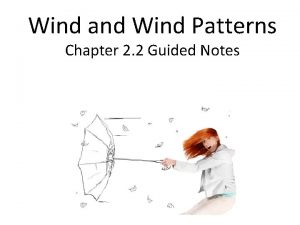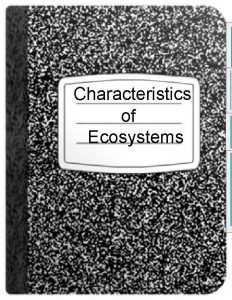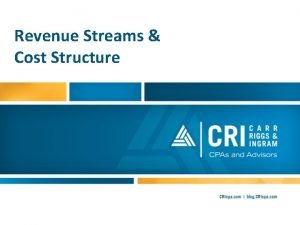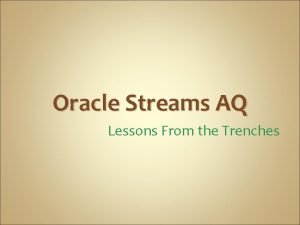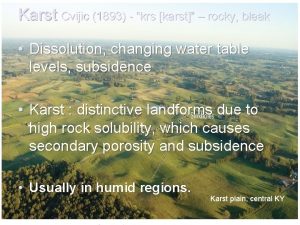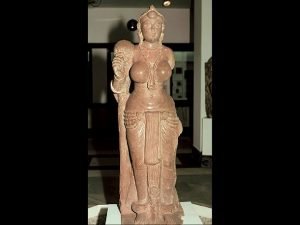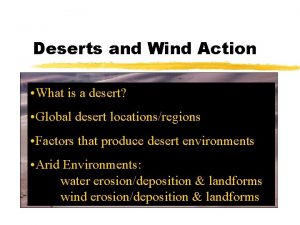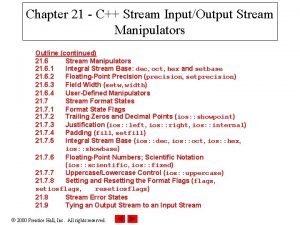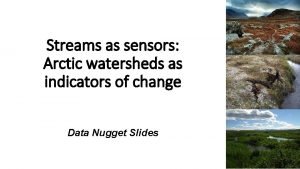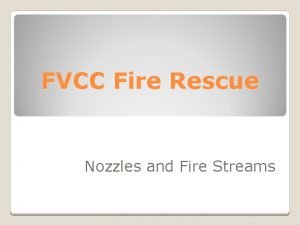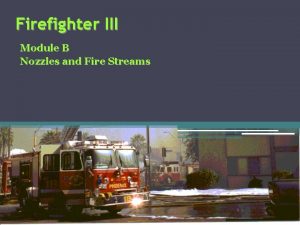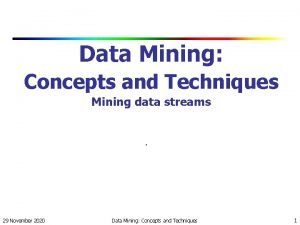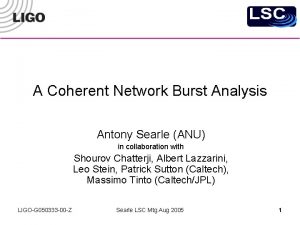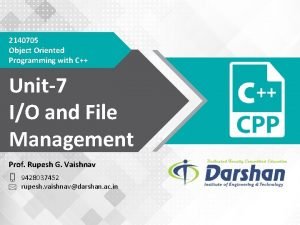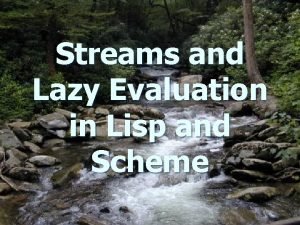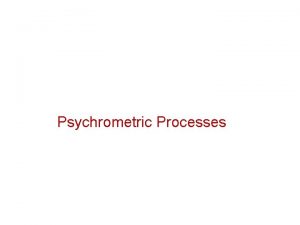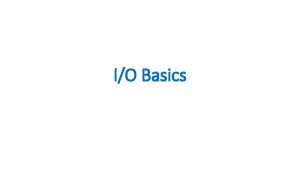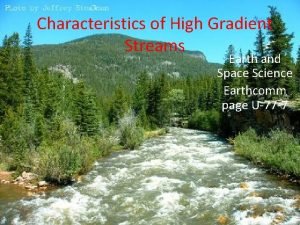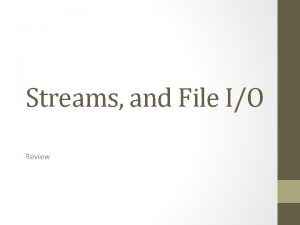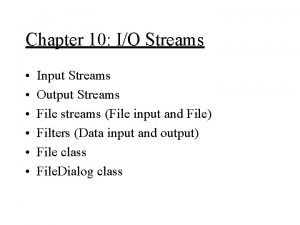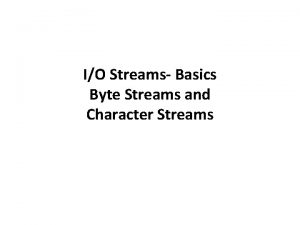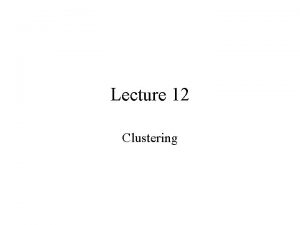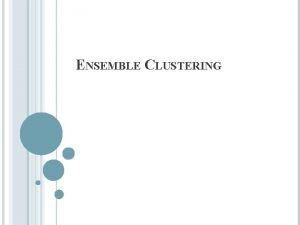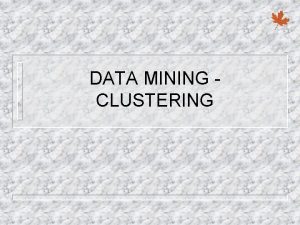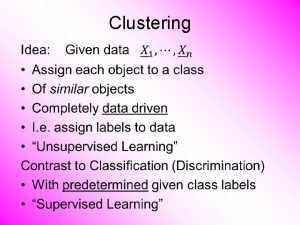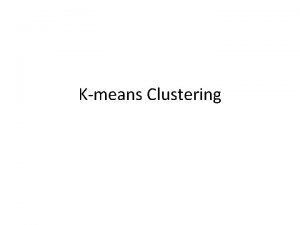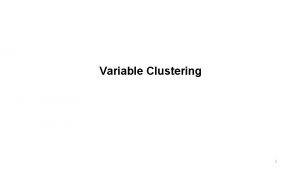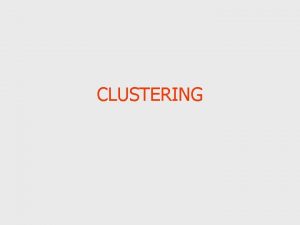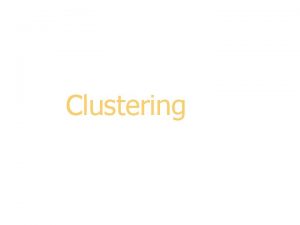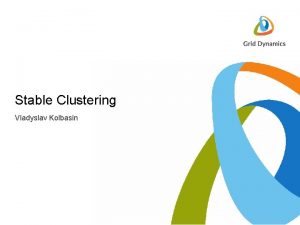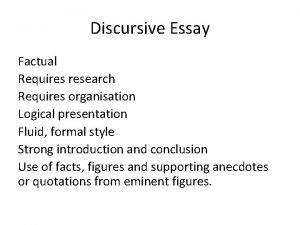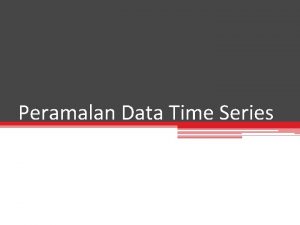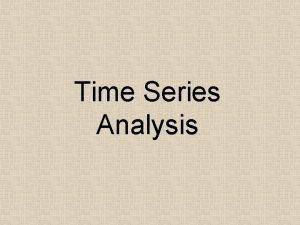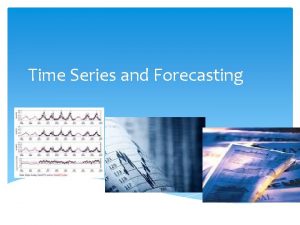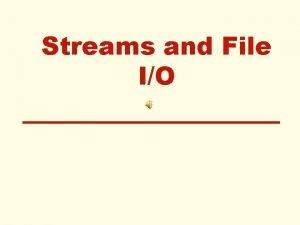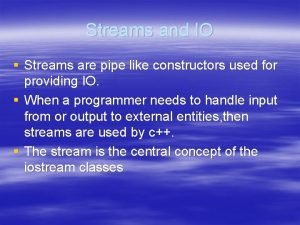Time Series Epenthesis Clustering Time Series Streams Requires























- Slides: 23

Time Series Epenthesis: Clustering Time Series Streams Requires Ignoring Some Data Thanawin Rakthanmanon Eamonn Keogh Stefano Lonardi Scott Evans

Subsequence Clustering Problem • Given a time series, individual subsequences are extracted with a sliding window. • Main task is to cluster those subsequences. Sliding window 2

Subsequence Clustering Problem Sliding window All subsequences Keogh and Lin in ICDM 2003. Subsequence clustering is meaningless. Centers of 3 clusters Average subsequence

All data also contains. . Transitions (the connections between words) • Some transitions has good meaning and worth to be discovered – The connection inside a group of words • Some transitions has no meaning/structure – ASL: hand movement between two words – Speech: (un)expected sound like um. . , ah. . , er. . – Motion Capture: unexpected movement – Hand Writing: size of space between words 4

How to Deal with them? Possible approaches are • Learn it! – Separate noise/unexpected data from the dataset. • Use a very clean dataset – dataset contains only atomic words. • Simple approach (our choice) – Just ignore some data. – Hope that we will ignore unimportant data. 5

Concepts in Our Algorithm Our clustering algorithm. . • is a hierarchical clustering • is parameter-lite – approx. length of subsequence (size of sliding window) • ignores some data – the algorithm considers only non-overlapped data • uses MDL-based distance, bitsave • terminates if. . – no choice can save any bit (bitsave ≤ 0) – all data has been used 6

Minimum Description Length (MDL) • The shortest code to output the data by Jorma Rissanen in 1978 • Intractable complexity (Kolmogorov complexity) Basic concepts of MDL which we use: • The better choice uses the smaller number of bits to represent the data – Compare between different operators – Compare between different lengths 7

How to use Description Length? 250 H A A' is A given H A' denoted as A' = A|H = A-H 0 0 50 100 If DL(A) > DL(A' ) + DL(H) 150 200 250 , we will store A as A' and H DL(A) is the number of bits to store A

Clustering Algorithm Current Clusters Create new cluster Add to cluster Create a cluster by 2 subsequences which are the most similar. Add the closet subsequence to a cluster. Merge clusters Merge 2 closet clusters. 9

What is the best choice? bitsave = DL(Before) - DL(After) 1) Create bitsave = DL(A) + DL(B) - DLC(C') - a new cluster C' from subsequences A and B 2) Add bitsave = DL(A) + DLC(C) - DLC(C') - a subsequence A to an existing cluster C - C' is the cluster C after including subsequence A. 3) Merge bitsave = DLC(C 1) + DLC(C 2) - DLC(C') - cluster C 1 and C 2 merge to a new cluster C'. The bigger save, the better choice. 10

Clustering Algorithm Current Clusters Create new cluster Add to cluster Create a cluster by 2 subsequences which are the most similar. Add the closet subsequence to a cluster. Merge clusters Merge 2 closet clusters. 11

Bird Calls Two interwoven calls from the Elf Owl, and Pied-billed Grebe. 0 0. 5 1 1. 5 2 2. 5 3 x 10 5 A time series extracted by using MFCC technique. 12

Input Create Motif Discovery Create Add Add Nearest Nighbor Merge Final Clusters Current Clusters 13

Bird Calls: Clustering Result Subsequences Center of cluster (or Hypothesis) Step 1: Create Step 2: Create Step 3: Add bitsave per unit Step 4: Merge 2 0 -2 -4 Create Add Merge Clustering stops here 1 2 3 4 Step of the clustering process 14

Poem The Bells In a sort of Runic rhyme, To the throbbing of the bells-Of the bells, To the sobbing of the bells; Keeping time, As he knells, In a happy Runic rhyme, To the rolling of the bells, -Of the bells, bells-To the tolling of the bells, Of the bells, Bells, bells, -To the moaning and the groaning of the bells. Edgar Allen Poe 1809 -1849 (Wikipedia)

The Bells: Clustering Result == Original Order == In a sort of Runic rhyme, To the throbbing of the bells-Of the bells, To the sobbing of the bells; Keeping time, As he knells, In a happy Runic rhyme, To the rolling of the bells, -Of the bells, bells-To the tolling of the bells, Of the bells, Bells, bells, -To the moaning and the groaning of the bells. == Group by Clusters == bells, Bells, bells, Of the bells, Of the bells, bells— To the throbbing of the bells-To the sobbing of the bells; To the tolling of the bells, To the rolling of the bells, -To the moaning and the groantime, knells, sort of Runic rhyme, groaning of the bells.

Summary • Clustering time series algorithm using MDL. • Some data must be ignored or not appeared in any cluster. • MDL is used to. . – select the best choice among different operators. – select the best choice among the different lengths. • Final clusters can contain subsequences of different length. • To speed up, Euclidean is used instead of MDL in core modules, e. g. , motif discovery. 17

Thank you for your attention 18

Supplementary

How to calculate DL? A is a subsequence. • DL(A) = entropy(A) – Similar result if use Shanon-Fano or Huffman coding. H is a hypothesis, which can be any subsequence. *DL(A) = DL(H) + DL(A - H) A 0 H A' – Compression idea; never use – directly in algorithm Cluster C contains subsequence A and B • DLC(C) = DL(center) + min(DL(A-center), DL(B-center)) 20

Running Time Koshi-ECG time series 0 motif length s = 350 500 1000 1500 2000 Cluster plotted Stacked, Dithered O(m 3/s) 21

ED vs MDL in Random Walk ED calculated in original continuous space MDL calculated in discrete space (64 cardinality) 22

Discretization vs Accuracy • Classification Accuracy of 18 data sets. • The reduction from original continuous space to different discretization does not hurt much, at least in classification accuracy. 23
 A framework for clustering evolving data streams
A framework for clustering evolving data streams Flat clustering
Flat clustering L
L Rumus distance
Rumus distance Gulf stream
Gulf stream Bill nye rivers and streams
Bill nye rivers and streams Cost streams
Cost streams Oracle streams
Oracle streams Disappearing streams karst topography
Disappearing streams karst topography Yakshi bracket figure
Yakshi bracket figure In the desert, ephemeral streams _____.
In the desert, ephemeral streams _____. Parameterized stream manipulator
Parameterized stream manipulator Data nugget streams as sensors answers
Data nugget streams as sensors answers Physical states
Physical states 3 types of fire streams
3 types of fire streams Oracle streams
Oracle streams Basic concepts in mining data streams
Basic concepts in mining data streams Antony searle
Antony searle Concept of streams
Concept of streams Streams and rivers abiotic factors
Streams and rivers abiotic factors Lisp lazy evaluation
Lisp lazy evaluation Sensible cooling on psychrometric chart
Sensible cooling on psychrometric chart Predefined streams in java
Predefined streams in java High gradient stream
High gradient stream




